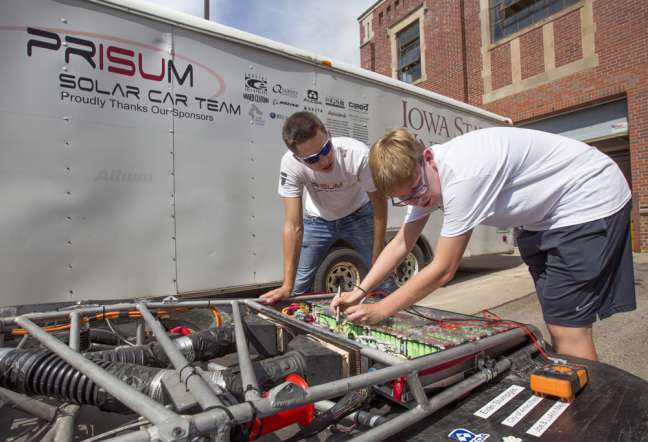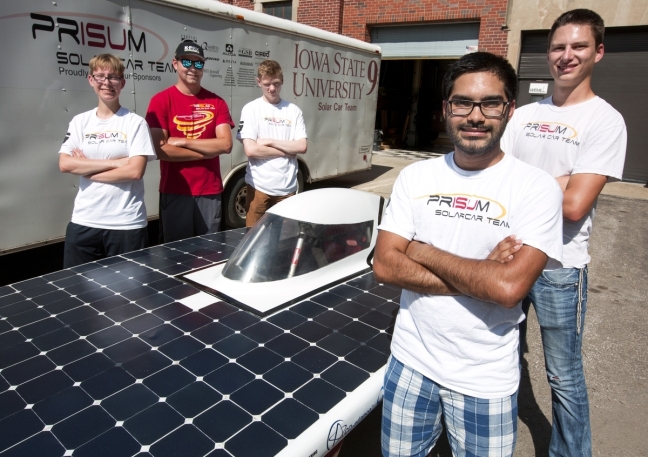
PrISUm team members Charlotte Brandenburg, right, and Matt Goode look over the car's batteries and fuses outside the team's Sweeney Hall garage. Larger photo. Photo by Christopher Gannon.
AMES, Iowa – Yes, of course, Team PrISUm will race to defend last year’s solar car title, said Matt Goode, the team’s project director. But – over eight days and 1,800 miles of racing from Ohio to South Dakota – the team is also chasing a bigger goal.
That’s developing a reliable car for a run at the 2017 World Solar Challenge – a race across Australia’s outback.
But first there’s America’s cross-country solar car race. And it won’t be a cruise in the park for Team PrISUm.
“I hope with all the upgrades we’ve made to the car that we’ll do well,” said Goode, a senior in materials science and engineering who’s from Coggon. “But you never know – there’s a lot of competition and some people will be gunning for us after last year.”
Last year, during the Formula Sun Grand Prix at the Circuit of the Americas Formula 1 race track in Austin, Texas, the team drove to its first overall victory. The team and its car, Phaëton, dominated the three days of grand prix racing, completing 31 more laps than the second-place team and scoring the fastest lap of the race by about 14 seconds. (The team named the car after the Greek sun god’s son who, according to mythology, begged to drive the sun chariot.)
Now the team is getting set to race an updated version of that car, “Phaëton 2,” at two races this summer. First is a qualifying race around the track at Pittsburgh International Race Complex, July 26-28. Then it’s the American Solar Challenge road race, July 30-Aug. 6.
The road race marks the 100th anniversary of the National Park Service by travelling from Cuyahoga Valley National Park in Brecksville, Ohio, to Wind Cave National Park in Hot Springs, South Dakota. Race checkpoints and stage stops will be at national battlefields, monuments and historical parks along the way. (The route takes the racers south across Missouri – it does not cross into Iowa.)
Team PrISUm’s student-engineers have made some major performance upgrades for this summer’s races:
- A new motor -- The team’s 15-year-old electric motor has been replaced with a new, custom-built, $15,000, 7.5 horsepower motor capable of about 70 mph. The new motor produces a little less power, but it’s lighter and far more efficient. The old motor turned about 80 percent of electrical power into motion; the new motor is about 95 percent efficient. And it’s quiet. “At 5 mph, there’s a slight hum,” Goode said. “After 5, it’s dead silent. It’s like a stealth fighter.”
- New batteries -- The team has switched to the same batteries that power the Tesla Model S sedan. The new batteries have a higher power density, so they charge faster and can power the car for about 200 miles, about 50 miles farther than the old batteries. But, the new batteries are also more sensitive to heat. Heat-tolerant batteries helped the team win in Austin last year. And so the team is working to improve the car’s ventilation and battery protection systems. “The battery protection system will cut off power at 120 degrees Fahrenheit,” Goode said. “If the ambient air temperature inside the battery pack is lower than that, we’re OK.”
- Live telemetry -- Fans will be able to follow some of the car’s data in real time over the internet. The public can go to the team’s website and check the exact location of the car. Team sponsors will also have access to technical data such as speed, solar array output and battery system details. “This gives one-on-one interaction between our team and anyone who is interested in or supportive of the team,” Goode said.
All those improvements should mean good racing for Team PrISUm and Phaëton 2. And all those new systems should get a good race test before the team builds its next car – a four-door, four-seat hatchback. That next-generation solar car will be named “Penumbra” (the edge of shadow around an eclipse) and it will be a functional passenger car, not a single-seater built for racing. The team’s goal is to take it to the World Solar Challenge in October 2017 and drive 1,900 miles across Australia, from Darwin to Adelaide.
"Our whole philosophy for this summer,” Goode said, “is that we’re testing a lot of systems that we’ll use on the four-seat car.”

Members of Team PrISUm -- from left, Charlotte Brandenburg, Garret Coleman, Philip Gates, Arun Sondhi and Matt Goode -- are preparing their solar racing car for this summer's two races. Larger photo. Photo by Christopher Gannon.
